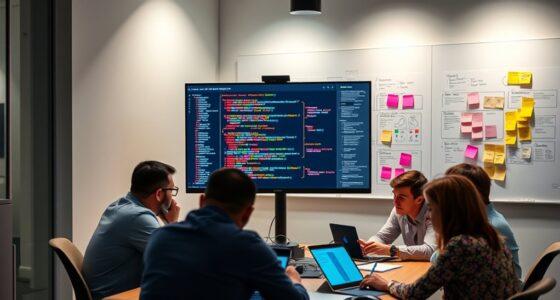To ethically develop AI and reduce bias, you can use transparent algorithms that openly share decision logic and data sources, making it easier to understand and scrutinize the system. Bias detection tools automatically identify unfair patterns and help you retrain models for fairness. Combining these techniques encourages accountability, promotes ongoing improvements, and guarantees your AI benefits everyone ethically. Keep exploring these strategies to build more responsible, equitable systems that can better serve diverse needs.
Key Takeaways
- Implement fairness-aware algorithms that adjust model training to reduce bias across demographic groups.
- Use diverse and representative datasets to minimize skewed data influence on model outcomes.
- Incorporate bias detection tools to identify and address unfair patterns during development.
- Apply techniques like re-weighting, re-sampling, or adversarial training to promote equitable model behavior.
- Maintain transparency by documenting decision logic and data sources to enable scrutiny and ethical evaluation.

Have you ever wondered how we can guarantee that artificial intelligence benefits everyone without causing harm? One of the key ways to achieve this is by focusing on techniques like algorithm transparency and bias detection. When developers open up their algorithms and clearly explain how decisions are made, it becomes easier to identify potential biases that could unfairly impact certain groups. Algorithm transparency isn’t just about making code available; it’s about providing insights into how data flows through the system, what factors influence outcomes, and where vulnerabilities might exist. This openness allows for scrutiny by diverse stakeholders, ensuring that biases don’t slip through unnoticed. Bias detection tools help automate this process, scanning models for patterns that might reflect societal prejudices or skewed data distributions. By implementing systematic bias detection, you can catch unfair tendencies early, before they influence real-world decisions. Incorporating ongoing AI in Education discussions can also inform best practices for ethical model development.
Transparency and bias detection are vital for developing fair, accountable AI systems that serve everyone ethically.
Transparency in algorithms also fosters accountability. When you have a clear understanding of how an AI model operates, it becomes easier to hold developers and organizations responsible for its outputs. You can ask critical questions: Is the training data representative? Are there hidden assumptions? Is the model’s decision-making process equitable across different groups? Addressing these questions helps prevent harmful biases from embedding into the system. Additionally, transparency encourages continuous improvement. When you can see where biases originate, you can take targeted measures—like refining data collection, adjusting model parameters, or incorporating fairness constraints—to mitigate those biases effectively.
Bias detection techniques aren’t just about catching issues after they appear; they’re about integrating proactive checks throughout the development process. For example, you can use fairness metrics to evaluate how different demographic groups are affected by the model’s predictions. If disparities arise, you can retrain or fine-tune the model to promote fairness. Combining bias detection with algorithm transparency creates a feedback loop, where insights lead to adjustments that improve the model’s ethical standing. This iterative process is essential for building AI systems that serve everyone equally and reduce the risk of reinforcing societal inequalities.
Ultimately, by prioritizing transparency and bias detection, you ensure that AI development aligns with ethical principles. These techniques empower you to identify, understand, and address biases early on, making AI systems more fair, trustworthy, and beneficial for all users. When developers and organizations commit to openness and vigilance, they lay the foundation for ethical AI that respects human rights and promotes social justice. This proactive approach isn’t just good practice; it’s crucial for creating AI that truly enhances our world without causing unintended harm.
Frequently Asked Questions
How Can Bias Be Detected in AI Models Effectively?
You can effectively detect bias in AI models by analyzing training datasets for imbalances and applying fairness metrics. Regularly evaluate your model’s outputs across diverse groups to spot disparities. Use tools that measure bias, such as demographic parity or equal opportunity, to quantify fairness. This proactive approach helps identify hidden biases early, ensuring your model treats all groups equitably and improving overall ethical standards.
What Are the Legal Implications of Biased AI Systems?
Bias in AI systems can land you in legal hot water, like a ship caught in a storm. You face legal liability if your biased models cause harm or discrimination. Regulatory compliance becomes essential, as authorities are increasingly scrutinizing AI fairness. Ignoring these issues could lead to hefty fines or lawsuits. So, you must proactively guarantee your AI systems meet legal standards to avoid costly repercussions and uphold ethical responsibility.
How Do Cultural Differences Influence AI Bias Mitigation Strategies?
Cultural perceptions considerably influence how you develop bias mitigation strategies, as what’s considered biased varies across cultures. You need to be bias-sensitive and adapt your approaches accordingly, recognizing different societal norms and values. By actively engaging diverse stakeholders, you ensure your AI respects cultural differences, reducing bias. This tailored approach helps create more equitable systems, fostering trust and inclusivity in global applications.
Can Bias Mitigation Techniques Reduce Model Accuracy?
You might worry that bias mitigation techniques will reduce model accuracy, but don’t throw the baby out with the bathwater. These methods aim to improve training data and enhance model fairness without sacrificing performance. In fact, a fairer model can be more reliable and trustworthy. With careful balancing, you’ll find that bias mitigation techniques can boost fairness while maintaining, or even improving, overall accuracy.
What Role Do Stakeholders Play in Ethical AI Development?
Stakeholder engagement is vital in ethical AI development because it guarantees diverse perspectives are considered, helping identify potential biases and ethical issues early. You should facilitate open communication and collaboration with stakeholders to foster ethical oversight throughout the process. By involving stakeholders, you actively promote transparency and accountability, which lead to more responsible AI systems that better serve societal needs and mitigate unintended harm.
Conclusion
As you forge ahead in developing ethical AI, imagine a landscape where fairness blooms like a steady sunrise, casting light on shadows of bias. With each technique you apply—diverse data, transparency, fairness checks—you weave a tapestry of trust and integrity. Feel the wind of responsibility guiding your steps, shaping models that serve all equally. Together, you can cultivate AI that reflects our best values, creating a future where technology uplifts and unites everyone in harmony.








